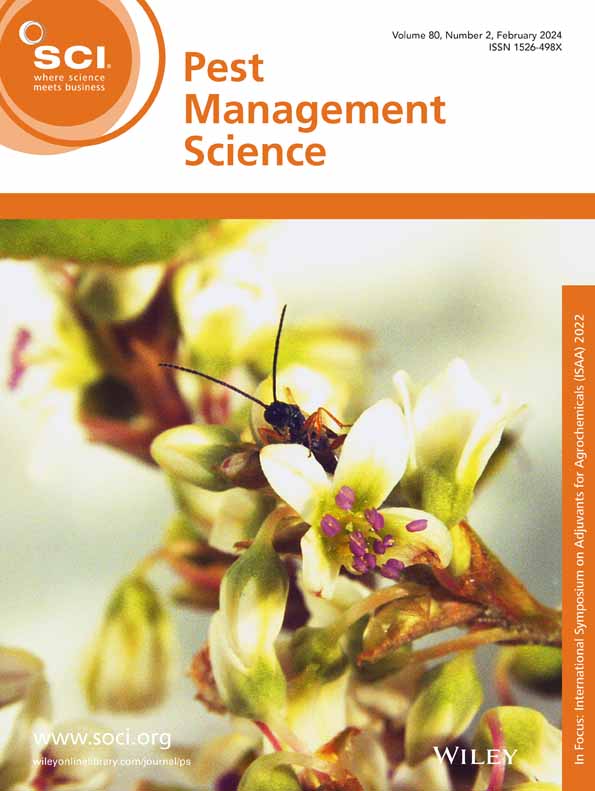曲霉木霉xy101挥发性有机物对梨溃疡病的生防活性及抑菌机理研究
IF 3.8
1区 农林科学
Q1 AGRONOMY
引用次数: 0
摘要
合成杀菌剂引起了人们对环境和健康的关注,微生物正在成为植物保护中有前途的天然拮抗剂。本研究评价了XY101及其挥发性有机化合物(VOCs)作为防菌剂对梨梨斑溃疡病的防菌效果,旨在明确其防菌机制和关键化合物。结果鉴定为曲霉木霉。曲霉木霉XY101在培养板上对Vasal pyri菌丝生长有明显抑制作用。定殖试验表明,XY101产生的挥发性有机化合物(VOCs)对梨离体枝条的致病性有显著的降低作用,抑制率为78.96%。扫描电镜和激光共聚焦显微镜显示,曲霉XY101产生的挥发性有机化合物引起菌丝超微结构的异常变化,破坏了真菌细胞膜的完整性。顶空固相微萃取-气相色谱-质谱(HS - SPME - GC-MS)分析结果显示,XY101菌株可检测出24种可能的挥发性有机化合物,其中3,7‐二甲基‐1‐辛醇和1‐辛醇为影响梨腐烂病的主要拮抗挥发性有机化合物。转录组分析表明,这些VOCs调节了病原真菌菌株中与代谢、膜损伤、致病性和抗性相关的基因表达。结论曲霉木霉XY101及其挥发性有机化合物3,7 -二甲基- 1 -辛醇和1 -辛醇- 3 -醇具有较好的抑菌效果,为开发以挥发性有机化合物为基础的梨腐烂病生物熏蒸剂提供了依据。©2025化学工业协会。本文章由计算机程序翻译,如有差异,请以英文原文为准。
Biocontrol activity and antifungal mechanisms of volatile organic compounds produced by Trichoderma asperellumXY101 against pear Valsa canker
BACKGROUNDSynthetic fungicides raise environmental and health concerns, and microorganisms are emerging as promising natural antagonists in plant protection. This study evaluated strain XY101 and its volatile organic compounds (VOCs) as biocontrol agents against pear Valsa canker caused by Vasal pyri , aiming to identify the antifungal mechanisms and key compounds.RESULTSThe biocontrol fungus was identified as Trichoderma asperellum . Trichoderma asperellum XY101 strongly suppressed the mycelial growth of Vasal pyri on culture plates. A colonization assay indicated that the VOCs produced by T . asperellum XY101 significantly reduced the pathogenicity of Vasal pyri on detached pear twigs, with an inhibition rate of 78.96%. Scanning electron microscopy (SEM) and laser confocal microscopy revealed that VOCs produced by T . asperellum XY101 caused abnormal changes in mycelial ultrastructure and damaged the integrity of fungal cell membrane. The results of headspace solid‐phase microextraction‐gas chromatography–mass spectrometry (HS‐SPME‐GC–MS) analysis showed the detection of 24 possible VOCs produced by strain XY101, with 3,7‐dimethyl‐1‐octanol and 1‐octen‐3‐ol identified as the primary antagonistic VOCs affecting pear Valsa canker. Transcriptome analysis demonstrated that these VOCs modulated gene expression in pathogenic fungal strains related to metabolism, membrane damage, pathogenicity, and resistance.CONCLUSIONTrichoderma asperellum XY101 and its VOCs, 3,7‐dimethyl‐1‐octanol and 1‐octen‐3‐ol, showed effective inhibitory effects against Vasal pyri , providing a basis for the development of VOCs‐based biological fumigants to manage pear Valsa canker. © 2025 Society of Chemical Industry.
求助全文
通过发布文献求助,成功后即可免费获取论文全文。
去求助
来源期刊

Pest Management Science
农林科学-昆虫学
CiteScore
7.90
自引率
9.80%
发文量
553
审稿时长
4.8 months
期刊介绍:
Pest Management Science is the international journal of research and development in crop protection and pest control. Since its launch in 1970, the journal has become the premier forum for papers on the discovery, application, and impact on the environment of products and strategies designed for pest management.
Published for SCI by John Wiley & Sons Ltd.
 求助内容:
求助内容: 应助结果提醒方式:
应助结果提醒方式:


